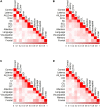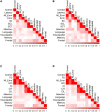Inhibitory Control of Saccadic Eye Movements and Cognitive Impairment in Mild Cognitive Impairment
- PMID: 35478701
- PMCID: PMC9038187
- DOI: 10.3389/fnagi.2022.871432
Inhibitory Control of Saccadic Eye Movements and Cognitive Impairment in Mild Cognitive Impairment
Abstract
Background: Mild cognitive impairment (MCI) may occur due to several forms of neurodegenerative diseases and non-degenerative conditions and is associated with cognitive impairment that does not affect everyday activities. For a timely diagnosis of MCI to prevent progression to dementia, a screening tool of fast, low-cost and easy access is needed. Recent research on eye movement hints it a potential application for the MCI screening. However, the precise extent of cognitive function decline and eye-movement control alterations in patients with MCI is still unclear.
Objective: This study examined executive control deficits and saccade behavioral changes in patients with MCI using comprehensive neuropsychological assessment and interleaved saccade paradigms.
Methods: Patients with MCI (n = 79) and age-matched cognitively healthy controls (HC) (n = 170) completed four saccadic eye-movement paradigms: prosaccade (PS)/antisaccade (AS), Go/No-go, and a battery of neuropsychological tests.
Results: The findings revealed significantly longer latency in patients with MCI than in HC during the PS task. Additionally, patients with MCI had a lower proportion of correct responses and a marked increase in inhibition errors for both PS/AS and Go/No-go tasks. Furthermore, when patients with MCI made errors, they failed to self-correct many of these inhibition errors. In addition to the increase in inhibition errors and uncorrected inhibition errors, patients with MCI demonstrated a trend toward increased correction latencies. We also showed a relationship between neuropsychological scores and correct and error saccade responses.
Conclusion: Our results demonstrate that, similar to patients with Alzheimer's dementia (AD), patients with MCI generate a high proportion of erroneous saccades toward the prepotent target and fail to self-correct many of these errors, which is consistent with an impairment of inhibitory control and error monitoring.
Significance: The interleaved PS/AS and Go/No-go paradigms are sensitive and objective at detecting subtle cognitive deficits and saccade changes in MCI, indicating that these saccadic eye movement paradigms have clinical potential as a screening tool for MCI.
Keywords: Go/No-go; frontal/executive function; inhibitory control; mild cognitive impairment; prosaccade/antisaccade; self-monitoring.
Copyright © 2022 Opwonya, Wang, Jang, Lee, Kim and Kim.
Conflict of interest statement
The authors declare that the research was conducted in the absence of any commercial or financial relationships that could be construed as a potential conflict of interest.
Figures





Similar articles
-
Deficits in saccadic eye movements differ between subtypes of patients with mild cognitive impairment.J Clin Exp Neuropsychol. 2021 Mar;43(2):187-198. doi: 10.1080/13803395.2021.1900077. Epub 2021 Apr 1. J Clin Exp Neuropsychol. 2021. PMID: 33792489
-
Inhibitory control of saccadic eye movements and cognitive impairment in Alzheimer's disease.Biol Psychiatry. 2005 May 1;57(9):1052-60. doi: 10.1016/j.biopsych.2005.01.017. Biol Psychiatry. 2005. PMID: 15860346
-
Uncorrected errors and correct saccades in the antisaccade task distinguish between early-stage Alzheimer's disease dementia, amnestic mild cognitive impairment, and normal aging.Neuropsychol Dev Cogn B Aging Neuropsychol Cogn. 2024 May;31(3):457-478. doi: 10.1080/13825585.2023.2198191. Epub 2023 Apr 2. Neuropsychol Dev Cogn B Aging Neuropsychol Cogn. 2024. PMID: 37004192
-
Prosaccade and Antisaccade Paradigms in Persons with Alzheimer's Disease: A Meta-Analytic Review.Neuropsychol Rev. 2018 Mar;28(1):16-31. doi: 10.1007/s11065-017-9362-4. Epub 2017 Oct 27. Neuropsychol Rev. 2018. PMID: 29079970 Review.
-
The application of saccades to assess cognitive impairment among older adults: a systematic review and meta-analysis.Aging Clin Exp Res. 2023 Nov;35(11):2307-2321. doi: 10.1007/s40520-023-02546-0. Epub 2023 Sep 7. Aging Clin Exp Res. 2023. PMID: 37676429
Cited by
-
Eye movement changes as an indicator of mild cognitive impairment.Front Neurosci. 2023 Jun 15;17:1171417. doi: 10.3389/fnins.2023.1171417. eCollection 2023. Front Neurosci. 2023. PMID: 37397453 Free PMC article.
-
Error monitoring in amnestic mild cognitive impairment: Cognitive correlates and relationship to measures of everyday function.Neuropsychology. 2023 Nov;37(8):933-942. doi: 10.1037/neu0000887. Epub 2023 Jan 23. Neuropsychology. 2023. PMID: 36689394 Free PMC article.
-
Prefrontal event-related potential markers in association with mild cognitive impairment.Front Aging Neurosci. 2023 Oct 19;15:1273008. doi: 10.3389/fnagi.2023.1273008. eCollection 2023. Front Aging Neurosci. 2023. PMID: 37927335 Free PMC article.
-
Feasibility of self-reported health related quality of life assessment with older people in residential care: insights from the application of eye tracking technology.Qual Life Res. 2023 Dec;32(12):3557-3569. doi: 10.1007/s11136-023-03488-w. Epub 2023 Jul 20. Qual Life Res. 2023. PMID: 37474850 Free PMC article.
-
Abnormal eye movements: relationship with clinical symptoms and predictive value for Alzheimer's disease.Front Aging Neurosci. 2024 Nov 21;16:1471698. doi: 10.3389/fnagi.2024.1471698. eCollection 2024. Front Aging Neurosci. 2024. PMID: 39640423 Free PMC article.
References
-
- Albert M. S., DeKosky S. T., Dickson D., Dubois B., Feldman H. H., Fox N. C., et al. (2011). The diagnosis of mild cognitive impairment due to Alzheimer’s disease: recommendations from the National Institute on Aging-Alzheimer’s Association workgroups on diagnostic guidelines for Alzheimer’s disease. Alzheimers Dement. 7 270–279. 10.1016/j.jalz.2011.03.008 - DOI - PMC - PubMed
LinkOut - more resources
Full Text Sources
Research Materials

